Deck 11: Crags,cracks,and Crumples: Crustal Deformation and Mountain Building
Question
Question
Question
Question
Question
Question
Question
Question
Question
Question
Question
Question
Question
Question
Question
Question
Question
Question
Question
Question
Question
Question
Question
Question
Question
Question
Question
Question
Question
Question
Question
Question
Question
Question
Question
Question
Question
Question
Question
Question
Question
Question
Question
Question
Question
Question
Question
Question
Question
Question
Question
Question
Question
Question
Question
Question
Question
Question
Question
Question

Unlock Deck
Sign up to unlock the cards in this deck!
Unlock Deck
Unlock Deck
1/60
Play
Full screen (f)
Deck 11: Crags,cracks,and Crumples: Crustal Deformation and Mountain Building
1
Shear stress at sufficient depth within a fault plane can induce plastic shear,forming a fine-grained metamorphic rock named ________.
A) ignimbrite
B) gneiss
C) mylonite
D) migmatite
A) ignimbrite
B) gneiss
C) mylonite
D) migmatite
C
2
Which of the following is NOT an example of deformation?
A) faults
B) folds
C) foliation
D) stratification
A) faults
B) folds
C) foliation
D) stratification
D
3
How does the rate at which a body of rock is deformed affect its behavior?
A) A rock deformed quickly is likely to exhibit brittle behavior.
B) A rock deformed slowly is likely to exhibit brittle behavior.
C) The rate of deformation has no effect on a rock's behavior.
D) The rate of deformation is important only below the brittle/plastic transition.
A) A rock deformed quickly is likely to exhibit brittle behavior.
B) A rock deformed slowly is likely to exhibit brittle behavior.
C) The rate of deformation has no effect on a rock's behavior.
D) The rate of deformation is important only below the brittle/plastic transition.
A
4
The distinction between joints and faults is that ________.
A) faults are joints that are greater than one square meter in areal extent
B) faults are fractures along which displacement has occurred; displacement does not occur along joints
C) joints are fractures along which displacement has occurred; displacement does not occur along faults
D) there is no distinction; the two terms are synonymous
A) faults are joints that are greater than one square meter in areal extent
B) faults are fractures along which displacement has occurred; displacement does not occur along joints
C) joints are fractures along which displacement has occurred; displacement does not occur along faults
D) there is no distinction; the two terms are synonymous

Unlock Deck
Unlock for access to all 60 flashcards in this deck.
Unlock Deck
k this deck
5
Under which condition would a body of rock be most likely to exhibit brittle behavior?
A) slow rate of deformation
B) low temperature
C) high temperature
D) high pressure
A) slow rate of deformation
B) low temperature
C) high temperature
D) high pressure

Unlock Deck
Unlock for access to all 60 flashcards in this deck.
Unlock Deck
k this deck
6
A body of rock affected by compressive stress will likely undergo ________.
A) shortening
B) stretching
C) shear strain
D) rotation
A) shortening
B) stretching
C) shear strain
D) rotation

Unlock Deck
Unlock for access to all 60 flashcards in this deck.
Unlock Deck
k this deck
7
An episode of mountain building is termed a(n)________.
A) orogeny
B) phylogeny
C) aureole
D) slickenside
A) orogeny
B) phylogeny
C) aureole
D) slickenside

Unlock Deck
Unlock for access to all 60 flashcards in this deck.
Unlock Deck
k this deck
8
A body of rock affected by tensile stress will likely undergo ________.
A) shortening
B) stretching
C) shear strain
D) rotation
A) shortening
B) stretching
C) shear strain
D) rotation

Unlock Deck
Unlock for access to all 60 flashcards in this deck.
Unlock Deck
k this deck
9
Why do earthquakes occur only above the brittle/plastic transition depth?
A) Below the transition,the rocks are too hot.
B) Below the transition,the rocks break too easily.
C) Above the transition,the rocks are too hot.
D) Above the transition,the rocks will flow.
A) Below the transition,the rocks are too hot.
B) Below the transition,the rocks break too easily.
C) Above the transition,the rocks are too hot.
D) Above the transition,the rocks will flow.

Unlock Deck
Unlock for access to all 60 flashcards in this deck.
Unlock Deck
k this deck
10
Right-lateral and left-lateral are both examples of ________ faults.
A) strike-slip
B) dip-slip
C) oblique-slip
D) reverse
A) strike-slip
B) dip-slip
C) oblique-slip
D) reverse

Unlock Deck
Unlock for access to all 60 flashcards in this deck.
Unlock Deck
k this deck
11
Which of these features would NOT help a geologist recognize a fault?
A) different rock units juxtaposed against each other
B) a small step on the landscape
C) a shattered rock consisting of visible angular fragments
D) regularly spaced quartz veins
A) different rock units juxtaposed against each other
B) a small step on the landscape
C) a shattered rock consisting of visible angular fragments
D) regularly spaced quartz veins

Unlock Deck
Unlock for access to all 60 flashcards in this deck.
Unlock Deck
k this deck
12
Which of these is NOT one of the components of deformation?
A) displacement
B) rotation
C) distortion
D) dissolution
A) displacement
B) rotation
C) distortion
D) dissolution

Unlock Deck
Unlock for access to all 60 flashcards in this deck.
Unlock Deck
k this deck
13
Movement along faults often produces a rock formed from sharply angled rock fragments termed ________.
A) fault gouge
B) rock flour
C) fault breccia
D) slickenside
A) fault gouge
B) rock flour
C) fault breccia
D) slickenside

Unlock Deck
Unlock for access to all 60 flashcards in this deck.
Unlock Deck
k this deck
14
The term for a change in shape induced by stress is ________.
A) plastic deformation
B) pressure release
C) strain
D) metamorphosis
A) plastic deformation
B) pressure release
C) strain
D) metamorphosis

Unlock Deck
Unlock for access to all 60 flashcards in this deck.
Unlock Deck
k this deck
15
Regularly spaced joints in an outcrop may indicate that an area ________.
A) is under intense shear stress
B) has experienced tension
C) is underlain by a thrust fault
D) is underlain by a magma body
A) is under intense shear stress
B) has experienced tension
C) is underlain by a thrust fault
D) is underlain by a magma body

Unlock Deck
Unlock for access to all 60 flashcards in this deck.
Unlock Deck
k this deck
16
How is stress different from force?
A) Force is the stress applied per unit area.
B) Stress is the force applied per unit area.
C) Force comes from one direction,while stress comes from all directions.
D) They are not different: stress and force are synonymous.
A) Force is the stress applied per unit area.
B) Stress is the force applied per unit area.
C) Force comes from one direction,while stress comes from all directions.
D) They are not different: stress and force are synonymous.

Unlock Deck
Unlock for access to all 60 flashcards in this deck.
Unlock Deck
k this deck
17
Force per unit area is termed ________.
A) stress
B) strain
C) power
D) work
A) stress
B) strain
C) power
D) work

Unlock Deck
Unlock for access to all 60 flashcards in this deck.
Unlock Deck
k this deck
18
How is stress different from strain?
A) Strain is a measure of the total displacement on a fault.
B) Stress is the change in shape of a rock due to applied strain.
C) Strain is the change in shape of a rock due to applied stress.
D) They are not different: stress and strain are synonymous.
A) Strain is a measure of the total displacement on a fault.
B) Stress is the change in shape of a rock due to applied strain.
C) Strain is the change in shape of a rock due to applied stress.
D) They are not different: stress and strain are synonymous.

Unlock Deck
Unlock for access to all 60 flashcards in this deck.
Unlock Deck
k this deck
19
Under which of these conditions would a body of rock be more likely to exhibit plastic behavior?
A) low temperature
B) high temperature
C) low pressure
D) high rate of deformation
A) low temperature
B) high temperature
C) low pressure
D) high rate of deformation

Unlock Deck
Unlock for access to all 60 flashcards in this deck.
Unlock Deck
k this deck
20
Normal,reverse,and thrust are all examples of ________ faults.
A) strike-slip
B) dip-slip
C) oblique-slip
D) lateral
A) strike-slip
B) dip-slip
C) oblique-slip
D) lateral

Unlock Deck
Unlock for access to all 60 flashcards in this deck.
Unlock Deck
k this deck
21
In the image below,the rocks have been bent into an elongate arch.This is a(n)________. 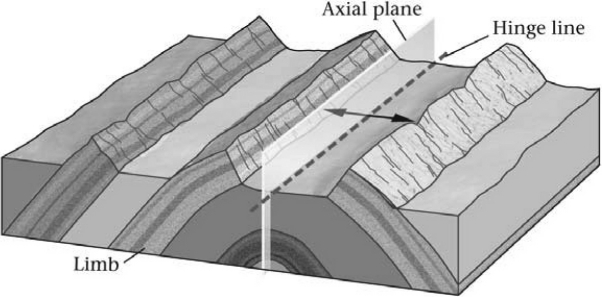
A) anticline
B) basin
C) dome
D) syncline

A) anticline
B) basin
C) dome
D) syncline

Unlock Deck
Unlock for access to all 60 flashcards in this deck.
Unlock Deck
k this deck
22
The rocks in the image below have been plastically deformed,resulting in a(n)__________. 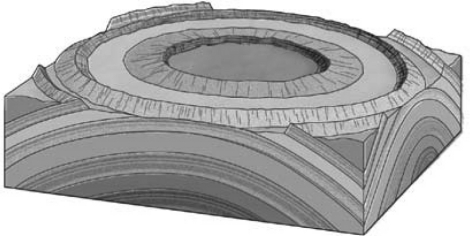
A) anticline
B) basin
C) dome
D) syncline

A) anticline
B) basin
C) dome
D) syncline

Unlock Deck
Unlock for access to all 60 flashcards in this deck.
Unlock Deck
k this deck
23
How is tectonic foliation,such as elongation of quartz grains,oriented relative to the original bedding plane of a body of rock?
A) Foliation is parallel to original bedding.
B) Foliation is at about 45° to original bedding.
C) Foliation is perpendicular to original bedding.
D) Foliation can be at a variety of angles to original bedding.
A) Foliation is parallel to original bedding.
B) Foliation is at about 45° to original bedding.
C) Foliation is perpendicular to original bedding.
D) Foliation can be at a variety of angles to original bedding.

Unlock Deck
Unlock for access to all 60 flashcards in this deck.
Unlock Deck
k this deck
24
On a geologic map,if the contacts between sedimentary rock units form a bull's-eye pattern of concentric circles,with the youngest unit in the center,the underlying structure is a(n)________.
A) anticline
B) basin
C) dome
D) syncline
A) anticline
B) basin
C) dome
D) syncline

Unlock Deck
Unlock for access to all 60 flashcards in this deck.
Unlock Deck
k this deck
25
A polished surface produced by scraping of rock along a fault is termed a(n)________.
A) orogeny
B) phylogeny
C) aureole
D) slickenside
A) orogeny
B) phylogeny
C) aureole
D) slickenside

Unlock Deck
Unlock for access to all 60 flashcards in this deck.
Unlock Deck
k this deck
26
The sides of a fold,where curvature is at a minimum,are termed ________. 
A) branches
B) limbs
C) axial planes
D) hinges

A) branches
B) limbs
C) axial planes
D) hinges

Unlock Deck
Unlock for access to all 60 flashcards in this deck.
Unlock Deck
k this deck
27
The central portion of high curvature on a fold is termed the fold ________.
A) limb
B) hinge
C) midsection
D) thorax
A) limb
B) hinge
C) midsection
D) thorax

Unlock Deck
Unlock for access to all 60 flashcards in this deck.
Unlock Deck
k this deck
28
In a ________ fault,the fault plane is non-vertical and the hanging-wall block moves downward relative to the footwall block.
A) detachment
B) normal
C) reverse
D) thrust
A) detachment
B) normal
C) reverse
D) thrust

Unlock Deck
Unlock for access to all 60 flashcards in this deck.
Unlock Deck
k this deck
29
The rocks in the image below have been plastically deformed,resulting in a(n)__________. 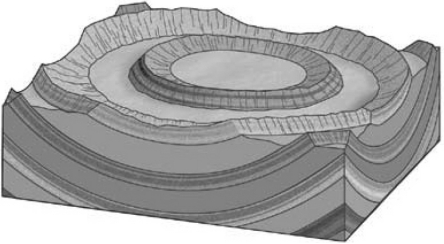
A) anticline
B) basin
C) dome
D) syncline

A) anticline
B) basin
C) dome
D) syncline

Unlock Deck
Unlock for access to all 60 flashcards in this deck.
Unlock Deck
k this deck
30
If a fault plane is less than 30° from horizontal and the hanging-wall block moves upward relative to the footwall block,the fault is a ________ fault.
A) detachment
B) normal
C) reverse
D) thrust
A) detachment
B) normal
C) reverse
D) thrust

Unlock Deck
Unlock for access to all 60 flashcards in this deck.
Unlock Deck
k this deck
31
During the formation of Pangea,Africa collided with North America and created the Appalachian Mountains.Which of the following mountain ranges is a modern analogue to the ancient Appalachian Mountains?
A) Andes Mountains
B) Sierra Nevada Mountains
C) Italian Alps
D) Cascade Mountains
A) Andes Mountains
B) Sierra Nevada Mountains
C) Italian Alps
D) Cascade Mountains

Unlock Deck
Unlock for access to all 60 flashcards in this deck.
Unlock Deck
k this deck
32
If a fault plane is greater than 35° from horizontal and the hanging-wall block moves upward relative to the footwall block,the fault is called a ________ fault.
A) detachment
B) normal
C) reverse
D) thrust
A) detachment
B) normal
C) reverse
D) thrust

Unlock Deck
Unlock for access to all 60 flashcards in this deck.
Unlock Deck
k this deck
33
On a geologic map,if the contacts between sedimentary rock units form a series of parallel lines,with the youngest unit in the center,the underlying structure is a ________. 
A) horizontal anticline
B) plunging anticline
C) horizontal syncline
D) plunging syncline

A) horizontal anticline
B) plunging anticline
C) horizontal syncline
D) plunging syncline

Unlock Deck
Unlock for access to all 60 flashcards in this deck.
Unlock Deck
k this deck
34
Normal faulting is most often associated with mountain building along ___________ boundaries,whereas reverse faulting is generally observed at ___________ boundaries.
A) divergent; transform
B) transform; convergent
C) convergent; divergent
D) divergent; convergent
A) divergent; transform
B) transform; convergent
C) convergent; divergent
D) divergent; convergent

Unlock Deck
Unlock for access to all 60 flashcards in this deck.
Unlock Deck
k this deck
35
A geologist's compass differs from the more widely known orienteering compass in that the geologist's compass ________. 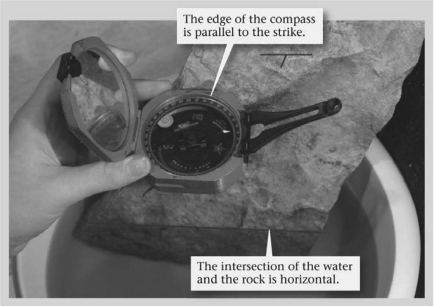
A) possesses an inclinometer,allowing the user to measure dip and plunge angles
B) contains a barometer that warns the geologist of approaching storms
C) can chemically analyze rock samples in the field
D) needle points directly toward geographic north rather than geomagnetic north

A) possesses an inclinometer,allowing the user to measure dip and plunge angles
B) contains a barometer that warns the geologist of approaching storms
C) can chemically analyze rock samples in the field
D) needle points directly toward geographic north rather than geomagnetic north

Unlock Deck
Unlock for access to all 60 flashcards in this deck.
Unlock Deck
k this deck
36
It is possible for offset along an oblique-slip fault to have both ________ and ________ components.
A) normal; reverse
B) right-lateral; left-lateral
C) normal; left-lateral
D) reverse; thrust
A) normal; reverse
B) right-lateral; left-lateral
C) normal; left-lateral
D) reverse; thrust

Unlock Deck
Unlock for access to all 60 flashcards in this deck.
Unlock Deck
k this deck
37
Mountain ranges formed along subduction zones are formed,in part,by ___________ in the crust.
A) compression
B) stretching
C) extension
D) elongation
A) compression
B) stretching
C) extension
D) elongation

Unlock Deck
Unlock for access to all 60 flashcards in this deck.
Unlock Deck
k this deck
38
In the image below,the rocks have been bent into an elongate trough.This is a(n)________. 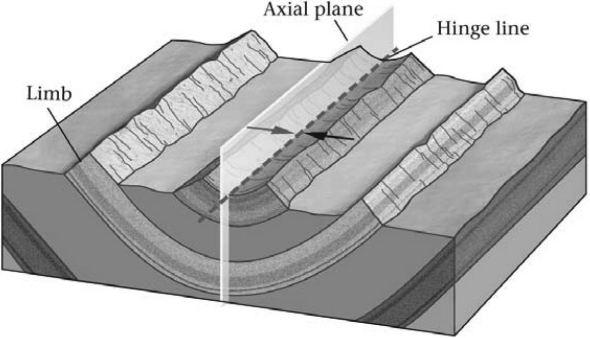
A) anticline
B) basin
C) dome
D) syncline

A) anticline
B) basin
C) dome
D) syncline

Unlock Deck
Unlock for access to all 60 flashcards in this deck.
Unlock Deck
k this deck
39
On a geologic map,if the contacts between sedimentary rock units form a bull's-eye pattern of concentric circles,with the oldest unit in the center,the underlying structure is a(n)________.
A) anticline
B) basin
C) dome
D) syncline
A) anticline
B) basin
C) dome
D) syncline

Unlock Deck
Unlock for access to all 60 flashcards in this deck.
Unlock Deck
k this deck
40
Which fault below could result from both strike-slip and dip-slip stresses? 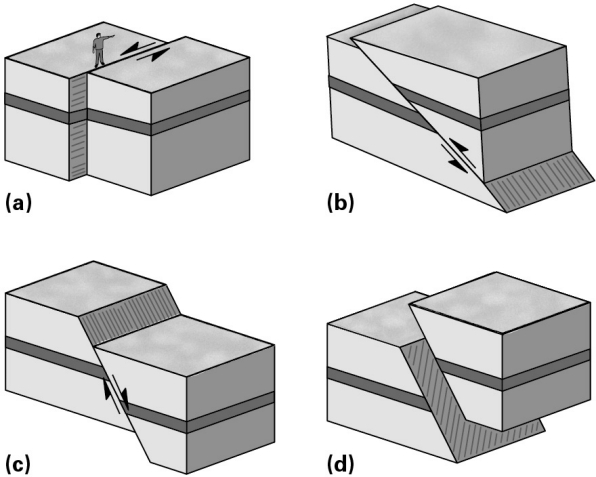
A) A
B) B
C) C
D) D

A) A
B) B
C) C
D) D

Unlock Deck
Unlock for access to all 60 flashcards in this deck.
Unlock Deck
k this deck
41
Regions where Precambrian metamorphic rocks are exposed at the surface are termed ________.
A) shields
B) cratonic platforms
C) convergent margins
D) domes
A) shields
B) cratonic platforms
C) convergent margins
D) domes

Unlock Deck
Unlock for access to all 60 flashcards in this deck.
Unlock Deck
k this deck
42
What can be said about the rates of uplift and erosion in a mountain that is gaining elevation? In a mountain decreasing in elevation? What is the ultimate fate of all mountains on the Earth?

Unlock Deck
Unlock for access to all 60 flashcards in this deck.
Unlock Deck
k this deck
43
Compare and contrast domes and basins.If both are composed solely of sedimentary beds that have been eroded such that the ground surface is level,how would you identify each?

Unlock Deck
Unlock for access to all 60 flashcards in this deck.
Unlock Deck
k this deck
44
What are the three components of deformation? Briefly explain each.

Unlock Deck
Unlock for access to all 60 flashcards in this deck.
Unlock Deck
k this deck
45
Compared to the Rocky Mountains,the Appalachian Mountains are a series of gently sloping hills.Have they always looked this way? Explain.

Unlock Deck
Unlock for access to all 60 flashcards in this deck.
Unlock Deck
k this deck
46
The formation of the Basin and Range Province,a fault-blocked mountain range in Utah,Nevada,and Arizona,is associated with which of the following processes?
A) continental rifting
B) continental collision
C) fold and thrust faulting
D) subduction zone volcanism
A) continental rifting
B) continental collision
C) fold and thrust faulting
D) subduction zone volcanism

Unlock Deck
Unlock for access to all 60 flashcards in this deck.
Unlock Deck
k this deck
47
There are many ways in which uplift can occur,but all of them reflect ________.
A) compressional forces
B) the effects of weathering and erosion
C) subduction zone processes
D) the lithosphere's tendency to achieve isostasy
A) compressional forces
B) the effects of weathering and erosion
C) subduction zone processes
D) the lithosphere's tendency to achieve isostasy

Unlock Deck
Unlock for access to all 60 flashcards in this deck.
Unlock Deck
k this deck
48
Contrast brittle and plastic deformation.Cite an example of a structure associated with each.

Unlock Deck
Unlock for access to all 60 flashcards in this deck.
Unlock Deck
k this deck
49
What can be said about a mountain range that is being uplifted at 2 cm/year but is not growing any taller?
A) The crustal root is thinning at the same rate as the uplift.
B) The crustal root is thickening faster than the uplift.
C) The rate of erosion is the same as the rate of uplift.
D) The rate of erosion is higher than the rate of uplift.
A) The crustal root is thinning at the same rate as the uplift.
B) The crustal root is thickening faster than the uplift.
C) The rate of erosion is the same as the rate of uplift.
D) The rate of erosion is higher than the rate of uplift.

Unlock Deck
Unlock for access to all 60 flashcards in this deck.
Unlock Deck
k this deck
50
Which of the following statements is true of the Appalachian Mountains?
A) The Appalachian Mountains first formed during the continental collision that resulted in the formation of Pangaea.
B) The Appalachian Mountains are the result of the extension that formed the Mid-Atlantic Ridge.
C) The Appalachian Mountains are an accreted terrain,formed during subduction that preceded modern tectonics.
D) The Appalachian Mountains include remnants of structures and rocks that formed during three distinct collisional orogenies.
A) The Appalachian Mountains first formed during the continental collision that resulted in the formation of Pangaea.
B) The Appalachian Mountains are the result of the extension that formed the Mid-Atlantic Ridge.
C) The Appalachian Mountains are an accreted terrain,formed during subduction that preceded modern tectonics.
D) The Appalachian Mountains include remnants of structures and rocks that formed during three distinct collisional orogenies.

Unlock Deck
Unlock for access to all 60 flashcards in this deck.
Unlock Deck
k this deck
51
What types of geologic structures would you expect to find in an area that had undergone compression?

Unlock Deck
Unlock for access to all 60 flashcards in this deck.
Unlock Deck
k this deck
52
What is the difference between a dip-slip fault and a strike-slip fault? Describe each and give specific examples (use sketches if that helps).

Unlock Deck
Unlock for access to all 60 flashcards in this deck.
Unlock Deck
k this deck
53
What is the primary reason why mountains substantially taller than Mt.Everest are unlikely to arise on Earth?
A) The high geothermal gradient in the crust causes mountains to collapse under their own weight.
B) Exhumation proceeds faster than uplift.
C) Extreme elevations cause chemical weathering to outpace uplift.
D) Uplift is limited by the rate of subduction.
A) The high geothermal gradient in the crust causes mountains to collapse under their own weight.
B) Exhumation proceeds faster than uplift.
C) Extreme elevations cause chemical weathering to outpace uplift.
D) Uplift is limited by the rate of subduction.

Unlock Deck
Unlock for access to all 60 flashcards in this deck.
Unlock Deck
k this deck
54
Draw a cross section of a normal and reverse fault.For each,list the stress involved and change in the length of the crust,if any.

Unlock Deck
Unlock for access to all 60 flashcards in this deck.
Unlock Deck
k this deck
55
__________ is the balance between the weight of a mountain range and the buoyancy provided by the underlying mantle.
A) Delamination
B) Suture
C) Isostasy
D) Orogen
A) Delamination
B) Suture
C) Isostasy
D) Orogen

Unlock Deck
Unlock for access to all 60 flashcards in this deck.
Unlock Deck
k this deck
56
The __________ is the succession of the opening of an ocean basin to form a passive margin,later followed by the closing of that ocean basin to form a collisional orogeny.
A) cratonic shield
B) Wilson cycle
C) orogenesis cycle
D) continental rift
A) cratonic shield
B) Wilson cycle
C) orogenesis cycle
D) continental rift

Unlock Deck
Unlock for access to all 60 flashcards in this deck.
Unlock Deck
k this deck
57
Compare and contrast a cratonic shield and platform.

Unlock Deck
Unlock for access to all 60 flashcards in this deck.
Unlock Deck
k this deck
58
Regions of continents that have NOT been subjected to orogeny during the past 1 billion years are termed ________.
A) exotic terranes
B) accreted terranes
C) cratons
D) cratonic platforms
A) exotic terranes
B) accreted terranes
C) cratons
D) cratonic platforms

Unlock Deck
Unlock for access to all 60 flashcards in this deck.
Unlock Deck
k this deck
59
Which of these properly illustrates the principle of isostasy?
A) High-density crust floats on top of low-density mantle.
B) Mountains stand high because they are gravitationally balanced by their deep crustal roots.
C) When weight is added to the crust,the crust responds by rebounding upward.
D) When material is removed from the crust,the crust maintains the new,lower elevation.
A) High-density crust floats on top of low-density mantle.
B) Mountains stand high because they are gravitationally balanced by their deep crustal roots.
C) When weight is added to the crust,the crust responds by rebounding upward.
D) When material is removed from the crust,the crust maintains the new,lower elevation.

Unlock Deck
Unlock for access to all 60 flashcards in this deck.
Unlock Deck
k this deck
60
How were the mountains in the Basin and Range Province formed?

Unlock Deck
Unlock for access to all 60 flashcards in this deck.
Unlock Deck
k this deck



